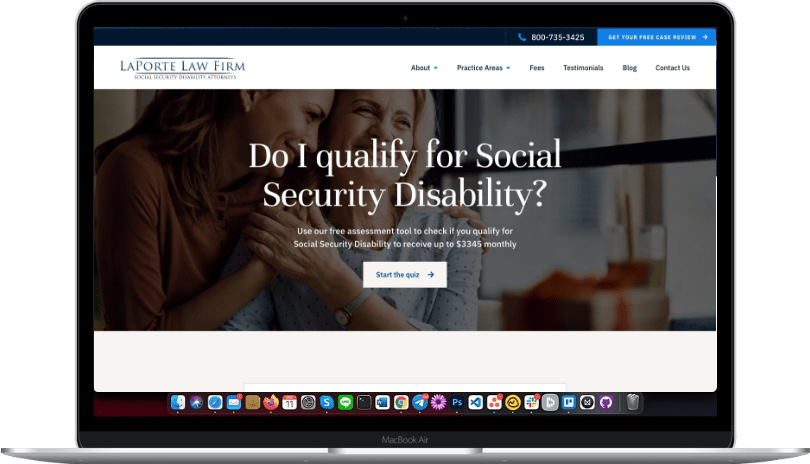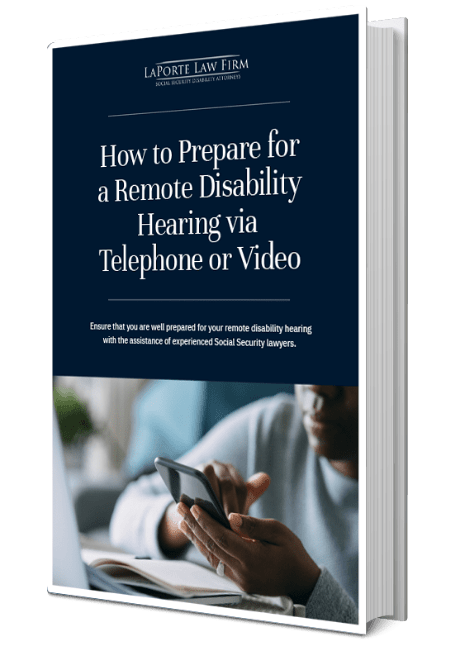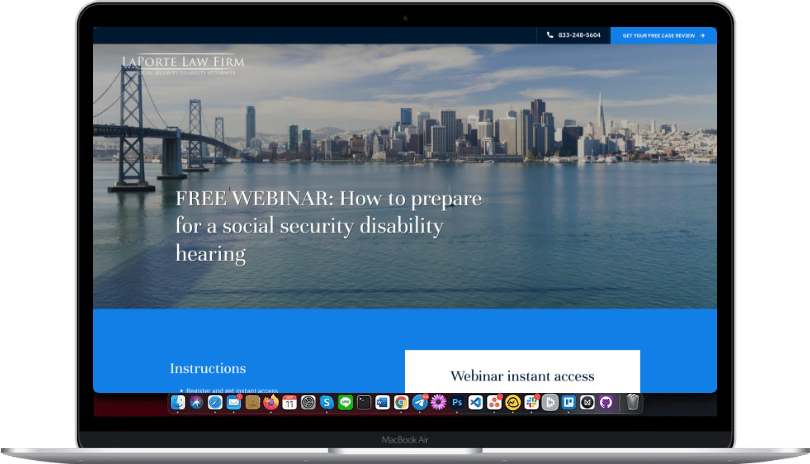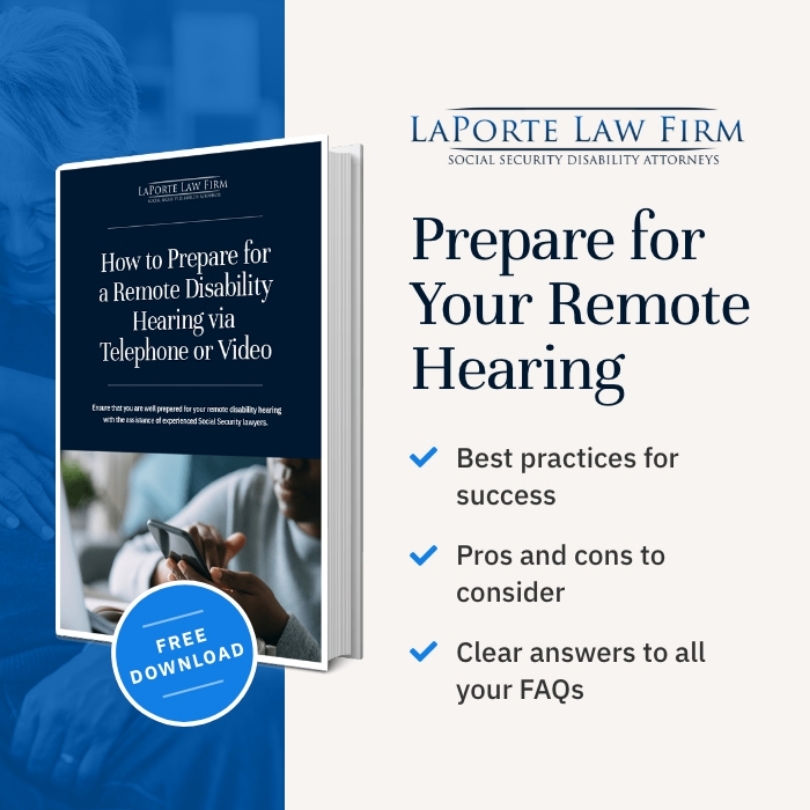
The public health impact of COVID-19 is still uncertain two and a half years into the pandemic caused by a novel virus. Some studies suggest that a staggering 25 million Americans currently suffer from some form of long COVID symptoms. Out of nearly 95 million confirmed cases of COVID in the United States, 30 percent of people who contract COVID could experience some form of lasting chronic condition.
If these predictions are accurate, one out of every 6 Americans will be living with a poorly understood and unpredictable chronic illness. Long COVID could become a “mass disabling event.” To complicate the situation, there is no objective test, such as an MRI or X-ray study, that SSA recognizes as proof of long COVID symptoms in a patient.
In August 2022, the Biden administration released a comprehensive list of services and supports for those suffering from long COVID. While the public health system in America is not well situated to support a large number of workers facing disability and job loss due to long COVID, the administration recognizes the Social Security system as a foundational pillar of the social safety net.
The question remains: how will our government and healthcare systems respond to this potential cascade of disability and long-term unemployment? One of the first places people who cannot work should turn to is the Social Security Administration’s disability programs to see if they qualify for financial assistance based on long COVID.
Another question remains – how will the Social Security Administration address claims for disability based on a new set of chronic conditions stemming from a once-a-generation novel coronavirus? The answer, as with most answers related to COVID-19, is complex and dependent on a number of factors.
This article will discuss the Social Security disability process, laws, and how the system is likely to adjudicate claims for disability on the basis of long COVID based on LaPorte Law Firm’s experience handling thousands of Social Security Disability Insurance (SSDI) cases since 1982.
Who Qualifies for Social Security Disability Insurance Benefits?
Before applying for disability based on long COVID, it’s important to understand who qualifies for Social Security benefits. Those who cannot work due to a disability, and whose condition has lasted or can be expected to last 12 continuous months, may be eligible for relief. The 12-month rule, or “duration rule”, is crucial to understanding how federal Social Security laws apply to a claim based on long COVID. Currently, the CDC defines long COVID as a condition that lasts “more than four weeks or even months after infection.” The CDC definition itself is vague and shows the uncertain nature of the condition since the duration of long COVID is not well defined. Two and a half years into the pandemic at the time this article is written, there is no medical consensus regarding how long those with long COVID will experience disabling symptoms.
Qualification Essentials
In addition to the 12-month rule, another foundational qualification for Social Security disability is that the claimant cannot be working or earning “substantial gainful income.” In 2022, the income threshold is a monthly gross pay of $1,350. (For more on the rules pertaining to work, refer to our longer article on the SSA’s definition of work.) This monthly work threshold applies across the United States, even to those who live in extremely expensive places such as the Bay Area.
A person who is able to continue working in their job and earning above $1,350 gross income per month, despite long COVID symptoms, is not eligible for Social Security disability. It does not matter how severe the long COVID symptoms are — if one continues to work and earn above the SSA monthly limit, they won’t qualify for SSDI. Social Security disability is only granted to those who cannot work or earn above $1,350 due to a condition. This work rule applies even if an employer provides workplace accommodations for long COVID symptoms, such as the ability to work from home, take breaks as needed, or miss work on an unscheduled basis.
Therefore, if you are contemplating a SSDI application, you should not apply while you are working. Every case is different, but in general it is advised to wait at least six months after you stop working to file an application for SSDI.
5 Questions: Social Security's Strict Definition of Disability
- Step 1: Are you working? If so, SSA issues an initial step 1 denial. The severity of the alleged disability will not be considered. If you are not working, SSA proceeds to step 2.
- Step 2: Is your condition severe? A severe condition impacts your ability to perform basic work-related activities for at least 12 months (see the 12-month rule discussed above). Your symptoms of long COVID should meet the SSA definition of severe. If the SSA agrees that your long COVID symptoms are severe, the case proceeds to the next step.
- Step 3: Does your condition meet the requirements of Listed Impairments? In general, a listing level impairment is a high bar to clear since the medical criteria usually require strict objective medical findings in the treatment evidence. If the SSA finds that you meet one of the medical listings, your case is approved automatically.
It is important to note that the SSA does not currently list long COVID as a listed impairment. In an Emergency Message regarding the evaluation of claims based on long COVID released on August 9, 2022, the SSA confirmed that a person applying for disability based on long COVID cannot meet a listing based on symptoms of long COVID alone. So a person who applies for disability based on long COVID will almost certainly be rejected at this step. However, that is not the end of the case; the SSA must go on to the next step in the evaluation process. - Step 4: Can you return to your past work? Past relevant work is any job you’ve performed in the past 15 years. If you can return to your past work, a claim for disability is denied at step 4. If not, the claim proceeds to step 5.
- Step 5: Can you do any other type of work in the national economy? This is a complicated hurdle to clear for people applying for disability based on long COVID symptoms, especially those who are under the age of 50. However, it is possible to be approved at step 5, as we will discuss below.
What Is Long COVID and Does It Qualify for SSDI Benefits?
Long COVID and Post-COVID Symptoms/Conditions
According to the CDC, long COVID causes a wide range of symptoms that include:
- Joint and muscle aches
- Brain fog
- Rapid heartbeat
- Fatigue
- Depression
- Shortness of breath
- Anxiety
These symptoms can be completely disabling or mild in presentation. The symptoms can last for days or years after the initial infection. Scientists and physicians are still studying this phenomenon, so our understanding of this disease is still evolving.
Furthermore, how long COVID will impact the disability system is still unclear, but regardless of the nature of a new disease impacting millions of people in varying ways, the Social Security regulations still apply to long COVID cases. As such, it’s important to learn about the fundamentals of Social Security law when assessing how a long COVID disability claim fits into the existing federal framework for disability.
Do People with Long COVID Qualify for SSDI?
Yes. However, Social Security does not recognize long COVID on the list of automatically qualifying conditions. Even if a condition is not a listed condition for which the SSA grants automatic benefits, Social Security must still consider the symptoms of long COVID when evaluating a person’s ability to perform their past work or other types of work.
In an August 9, 2022 Emergency Message, the Social Security Administration confirmed that Long Covid is a “medically determinable impairment” that must be evaluated under the same five-step framework for any other disabling condition for severity, duration, and the impact of symptoms on a person’s ability to perform a sustained work activity. The Emergency Message recognizes the novelty of long COVID and that the medical community is still studying the long-term effects of the condition. If long COVID meets the duration requirements of the disability program, a claimant can be approved for Social Security disability on the basis of long COVID alone. You are also eligible for disability if the combination of your impairments related to long COVID and other health impairments prevent you from working.
Proving Your Disability to the Social Security Administration: A Challenge with Long COVID
It is critical that you maintain consistent treatment with your doctors for the duration of an SSA claim, especially since SSA claims can last over one year from the date of application to an administrative hearing with a judge. Although there are no current SSA-accepted diagnostic tests to establish long COVID, the SSA can use reported symptoms in your medical records to determine the nature and severity of your long COVID.
It should also be noted that the scientific understanding of long COVID is evolving, with some research by the National Institute of Health indicating that SPECT testing can establish perfusion defects indicative of long COVID. A SPECT (single-photon emission computerized tomography) can help your doctor assess the functioning of your heart, brain, and bones. Even if MRI, X-ray, CT scans of the chest, etc. are normal, you should ask your doctor whether a SPECT test is indicated for your long COVID symptoms.
Long COVID presents a unique type of challenge because it is a condition that does not currently have a specific prescribed treatment, similar to chronic fatigue syndrome myalgic encephalomyelitis (ME). If you are suffering from brain fog (deficits in concentration, memory, word finding, executive functioning, etc.) months after recovering from a COVID infection, talk to your doctor about neuropsychological testing. These tests will assess your memory, ability to concentrate, and decision-making skills, among other things. They are administered by a neuropsychologist and can be powerful evidence of a medically determinable impairment, as required by the Social Security Administration. They also help establish a baseline for how your cognition is functioning several months after the onset of symptoms. Often, a second neuropsychological test will take place one year after the initial neuropsychological test to determine the progression of the brain fog symptoms. It is important to follow up with your physician about the second annual neuropsychological test and to see a specialist if your physician refers you to one.
If long COVID is also impacting your mental health in addition to physical health, seek treatment with a psychiatrist or psychologist. Not only is mental health treatment important for your well-being, but the notes from a psychiatrist or psychologist can be used to show the impact of long COVID on your everyday life and therefore your ability to perform work. It is critical to describe in detail your symptoms to your mental health provider. You should keep notes regarding the impact of long COVID on your day-to-day activities and report your symptoms clearly and consistently to your physician.
Given the unpredictable nature of the pandemic in combination with unreported long COVID symptoms, the impact of long COVID on the economy is still unknown. The SSA does not report the number of disability claims for long COVID that they’ve approved; however, the SSA reported in March 2022 that 23,000 claims for disability have included some mention of COVID, which reflects 1% of all claims since the start of the pandemic. Experts have studied the Social Security Administration’s disability application caseload to evaluate whether long COVID is resulting in an increase in official disability claims.
Those results are likely not instructive due to a variety of other factors. Since the beginning of the pandemic, overall claims for disability dropped 10%. Social Security field offices were closed in March 2020, and did not reopen for in-person appointments until April 2022. These closures likely impacted the number of disability claims, since many people apply for benefits in person at their local SSA field office, especially those who lack access to reliable internet services. Those who did go to their local Social Security office faced long lines and increased wait times to access basic services, such as in-person disability applications. Since local field offices conduct many different types of essential services in addition to processing applications, such as correcting errors in current benefit payments, the number of claims filed since the start of the pandemic is not a reliable metric for the impact of long COVID on disability claims. As with COVID hospitalizations, SSA claims could be a lagging indicator for the prevalence of disabling long COVID.
While claims for disability based on COVID lag, self-reported symptoms have stayed relatively even since 2019. The National Health Institute, a federal agency, conducts an annual study asking Americans whether they have difficulty performing basic tasks such as concentrating, walking up stairs, or performing self-care such as bathing or grooming. The number of Americans reporting difficulty with these everyday basic activities has stayed relatively flat every year since 2019. However, anecdotal evidence suggests that those suffering from long COVID may apply for disability by citing other, more recognizable conditions.
Further, because those with long COVID don’t know if and when their symptoms will subside, many may forgo a claim for disability due to the unappealing prospect of undertaking a long federal disability claim that can last years with appeals. The complexity of the condition and the Social Security system can act as a deterrence. However, we strongly suggest consulting a disability attorney to better understand the rules, wait times, and best practices regarding medical treatment. A claim for disability takes patience, persistence, and diligence, but it’s entirely possible to receive much-needed financial assistance for long COVID. It can be a long road, but a secure monthly payment and critically important medical insurance can be worth the time and effort.
What Are the Disability Benefits for Long COVID Patients?
If you suffer from long COVID, you may receive the following benefits from the SSA:
Financial benefits
Your Social Security disability benefit is based on your FICA taxed earnings. Every person with long COVID has a unique monthly benefit amount based on work history. The current average monthly benefit in 2022 is approximately $1,544.70. To find out your monthly benefit if approved, we strongly recommend creating a Social Security account to check your numbers. Before embarking on the disability process, it’s important to understand the potential disability income so you can plan for the future.
Health Insurance Benefits (Medicare)
Social Security disability beneficiaries are also entitled to Medicare benefits. Medicare begins two years after your first entitlement month for disability. Medicare enrollment occurs regardless of disability. So, a person who qualifies for disability based on long COVID is entitled to Medicare two years after entitlement. Entitlement for disability begins one year prior to the month of a disability application at most, and there is a five-month waiting period for entitlement. The five-month waiting period begins the month of the established onset date, or in other words, the date that SSA agrees a disability began.
Take the following two examples regarding Medicare entitlement for long COVIDdisability claims:
Example 1: Person A filed an application for disability in January 2022, with an alleged onset date of March 2020 when they first contracted COVID. The SSA approved the application with an established onset date (established onset date = the date SSA determines the disability began) of March 2020. Person A’s retroactive pay starts January 2021, 12 months prior to the application date of January 2022. Medicare begins on January 2023, two years after the first month of entitlement.
Example 2: Person B filed an application in the same month as Person A, in January 2022. However, Person B contracted long COVID in January 2021, and alleged that month as the start date of the disability. The SSA approved Person B’s application with an established onset date of disability of January 2021. Person B is entitled to retroactive disability as of June 2021 (there’s a five-month waiting rule from the established onset date of the disability). Person B is therefore entitled to Medicare beginning June 2023, two years after their disability entitlement date.
As you can see, the timing of an application and the date you allege disability have a significant impact on your disability retroactive period and Medicare start date. A disability lawyer can help you understand the potential outcomes of a disability application, and discuss the best time to apply for disability to maximize your potential retroactive award and Medicare onset dates. Dates are critical in Social Security cases, so make sure to gather information related to your disability timeline, including the exact date you contracted COVID, first went to the doctor for COVID treatment, and the day you stopped working, to better assist your attorney when discussing your case.
Here's How You Should Proceed
Before applying for Social Security benefits, consult a local SSDI attorney to discuss the process and relevant laws as they apply to your case. Consultations are at no cost to you, so even if you cannot obtain an attorney to help with your disability application, you should seek free advice from an experienced lawyer.
An attorney can help you avoid some of the common pitfalls of applying for disability. A common misguided suggestion to disabled workers is that they should apply “right away” because the disability process takes so long. Except in rare cases, an early application can result in unnecessary initial denials, forcing the applicant to undergo lengthy appeals. For example, many people apply for disability too early after stopping work. When the SSA reviews their medical records, there is insufficient evidence to make a determination regarding the 12-month rule, because the early applicant stopped working due to long COVID only recently. If the medical records only cover a period of several months after the claimant stopped working, the SSA will issue a “durational denial,” indicating that the claimant has not proved that long COVID will prevent them from working for at least 12 months.
Another common pitfall is applying for disability without undergoing the appropriate treatment. If a person applies on the basis of long COVID but does not seek treatment for their condition, the SSA will deny the application on the basis of insufficient evidence. Even if the person has a primary care physician, some applicants are denied because the medical records do not adequately reflect the severity of their long COVID.
Is Long COVID SSDI Qualification Proving to Be a Struggle? A Social Security Disability Attorney Can Help You
If you are considering applying for disability on the basis of your long COVID symptoms, call LaPorte Law Firm right away to schedule a free consultation. Consulting with us can help you understand your options and determine when the best time to apply for disability is. Especially in Long COVID cases, the timing of an application for disability in relation to your disability onset date or work stoppage is crucial.
An appointment with one of our attorneys is entirely free. If you retain us to help represent you on an application or appeal, representation is at no cost to you until your case is approved. In fact, there are no out-of-pocket costs until you get paid. Please review our fees page to learn more about contingency fee agreements in Social Security cases.
Conclusion
The laws that apply to SSDI cases do not yet codify long COVID as a disabling condition, and the system favors medical conditions that are easily recognized by objective studies. Long COVID is an ongoing public health crisis. The nature of the challenge should not be minimized. Those suffering from long COVID face challenges with obtaining proper medical care and the federal benefits that can be a lifeline during an uncertain period of impairment. However, these facts should not dissuade you from seeking the financial and medical assistance you deserve. As long COVID cases increase, those with long COVID will be approved for SSDI benefits.
At LaPorte Law Firm, we believe it is important to have honest conversations with our clients regarding the nature of the SSA system and the length of a disability case. Our clients go into the process knowing what to expect. Equipped with this knowledge, they are better able to plan their future, seek appropriate treatment, and ultimately succeed in their claims for disability. If you are thinking about applying for disability due to long COVID, contact us for a free consultation. We are here to help.
FAQs
There are several public benefits available to those who cannot work due to a disability. If you worked in a job that paid California State taxes, you may be eligible for short-term state disability (SDI) benefits. State disability benefits are payable for 12 months from the date of the claim. If your long COVID has lasted or can be expected to last for 12 months or more, you may qualify for Social Security benefits. If you are a California State employee, you may be eligible for CALPERS disability retirement. If you work for a private employer, contact your HR representative to find out if you are eligible for Long-Term Disability benefits through a private insurance company (LTD).





